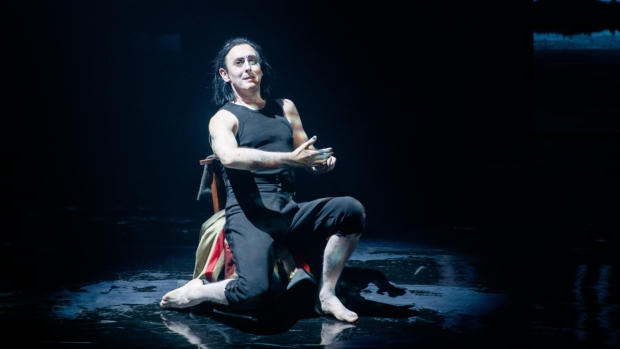”Burn” starring Alan Cumming at King’s Theatre – Edinburgh International Festival review

© Tommy Ga-Ken Wan
Alan Cumming made his “return” to the Edinburgh International Festival in 2007, starring in the National Theatre of Scotland’s production of The Bacchae. He has been back several times under Fergus Linehan’s directorship, mostly as a cabaret artiste, and now, in Linehan’s final festival, he fronts the main drama production of the first week.
Burn is Cumming’s meditation on and tribute to Rabbie Burns, Scotland’s national Bard. Created alongside choreographer Steven Hoggett, one of his objectives was to get to the real man beneath the shortbread tin image, what’s left when you scrape away the much-quoted verse. Cumming describes Burns as “a hot mess” who struggled with desire, physical affliction and mental health, and this one-man, one-hour show seeks to unmask that mess and interrogate him as a flesh-and-blood character.
Throughout, nostalgia is married to modernity. You see the nostalgia instantly in the show’s look, a black stage with a desk, some chairs and some bundles of clothes. Cumming himself wears close-fitting black dance gear that matches his jet-black hair and painted black nails, contrasting the whitened skin of his face, arms and legs. Consequently the whole visual aesthetic has the whiff of an old black-and-white movie, matched by the monochrome projections that light up the back wall.
Burn has been billed as a dance piece, but that’s the wrong element to focus on. There’s rhythmic movement aplenty, but it’s often closer to mime or even sign language. Cumming moves in time to his own rhythmic speech, jerking in a particular direction to emphasise certain words, but that fades out after the first ten minutes, and the focus lands, as it should do, on the language.
Drawn from Burns’ poetry and letters, the narrative is partly Burns’ biography from his poverty-stricken upbringing to his dreary life as an exciseman; but we also open windows into his feelings: his hopes, fears, dreams, worries and, importantly, his loves. The tone is wistful, tinged with mischief, and there is rhythmic musicality in its spirit, just as there is in the poetry. It captures the backward-looking mood very well, and it’s an effective way of getting inside the poet’s mind and revealing his personality. Props glide in and out to suggest places, people and situations, one standout being a bunch of rags that, when raised elegantly skywards, turns out to be the dress of one of his great lost loves.
Cumming is the master of his material. He has clearly loved getting under the skin of the poet, one Scottish icon reflecting on another, and there is unmistakeable passion in his performance as he brings his own project to fruition. If there’s a problem then it’s that the episodic nature of the piece feels ultimately quite scattergun. For all the talk about uncovering Burns’ mental health issues (such as suspected depression, or even bipolar disorder), this never goes too deep. In fact, several scenes dissolve into another at the very moment that they’re about to become interesting. That’s a source of frustration, and one of the reasons I found the show diverting rather than gripping. Nor does it help that the final five minutes become unnecessarily frantic, the dance becoming chaotic against a blur of changing colours.
Still, Cumming’s conviction makes him easy to watch, and it’s a neat touch to end the play with Burns, a man like any other, reciting “Auld Lang Syne” in front of the curtain, one of us after all.












